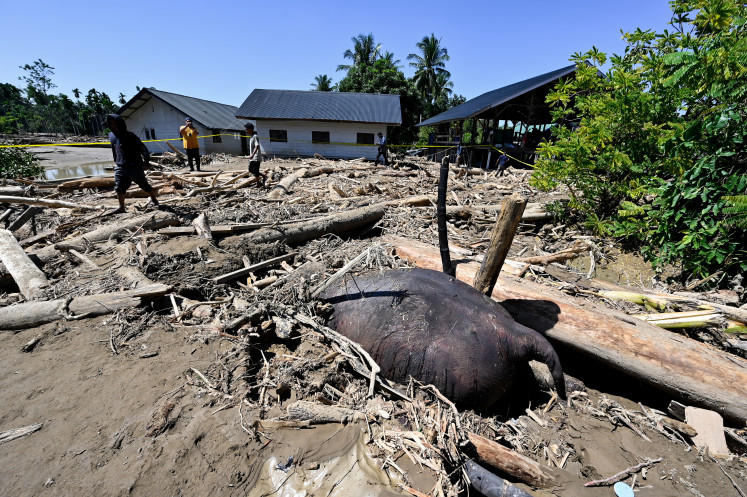Popular Reads
Top Results
Can't find what you're looking for?
View all search resultsPopular Reads
Top Results
Can't find what you're looking for?
View all search resultsThe tarnished future of Kotagede silver
Rare skill: Marni, 25, from Kotagede, Yogyakarta, applies herself to making jewellery, in Salim Silver’s workshop, in Oct
Change text size
Gift Premium Articles
to Anyone
R
span class="caption">Rare skill: Marni, 25, from Kotagede, Yogyakarta, applies herself to making jewellery, in Salim Silver’s workshop, in Oct. 2009. JP/Yuliantoro
Kotagede’s fame as a silver town is not limited to Indonesia, but is evenly spread throughout the world. In the 18th century, the Mataram Palace appointed Kotagede as a silver handicraft center to meet the palace’s needs.
Consequently the fine art work and engraving produced in the town have been complex and of high quality.
The silver handicrafts of Kotagede experienced their peak when they went international in the 1930s. This was largely thanks to Mrs Mary Agnes Van Gesseler Versvir, the wife of the Dutch East Indies governor who exercised power in Yogyakarta from 1929 to 1932.
The Dutchwoman was so impressed with Kotagede silver handicrafts that she ordered many to be sent to the Netherlands.
Drs Pim Westerkamp MA, the curator of Southeast Asian Culture and History at the Tropenmuseum in the Netherlands, said that the Dutch Tropenmuseum currently stored at least 62,000 examples of Kotagede silver handicrafts from Yogyakarta, covering production between 1929 and 1932.
The collection of silver handicrafts includes silver bowls, cake plates, cup sets and teapots, wine cups and more. A large part of the collection carries relief motifs of the Prambanan Temple, the Boko Queen, the Jepara Mantingan Mosque, motifs from West Sumatra and elsewhere.
In the 1930s, all the silver craft industries experienced growth.
Soon after Indonesia became independent, the international prestige of Kotagede silver began to fade, especially after the confrontation with Malaysia, followed by Indonesia leaving the UN and the events of Sept. 30, 1965.
In the 1970s, after the political situation started to stabilise, Kotagede silver was back in fashion and triumphant again.
Because Indonesia opened its doors to the outside world, especially with the tourism sector, silver goods became popular among consumers and jewellery businesses, and were marketed by art shops in the Kotagede area.
The results were very profitable and the living standards of the community improved, so that almost the entire community of Kotagede was eking a living out of making silver handicrafts.
A dying art: Wasik, 60, makes a pendant out of silver in Salim Silver’s. JP/Yuliantoro
Unfortunately, over time, and particularly since the early 1990s, silver craft industries in Kotagede are no longer prevalent. The shocks to the economy from the monetary crisis in 1998, the 2006 earthquake, the increasing price of fuel and the global crisis from 2007 to 2008, have made Kotagede silver craft industries seem ready to give up or simply survive.
A Kotagede silver entrepreneur, Priyo Jatmiko Salim, who owns Salim Silver, said that since the late 20th century, silver craft had shifted from an art form to an industry of mass-produced goods, purely based on economic value.
The fine engraved silver artwork with its characteristic hallmark identifying it as part of Kotagede’s cultural heritage is now rarely found in showrooms.
“Look at the silver shops. Is there an engraved silver product there that has any semblance of art?” Priyo asked.
The shift from art to mass production began during the 1998 economic crisis. Priyo added that the weakened rupiah had sharply increased the price of silver raw materials, while at the same time reduced buyers’ purchasing power.
There were no more major orders for household goods such as tea, dinner sets, bowls and large handicrafts.
“When silver was Rp 400,000 [US$42] per kilogram [before 1998], we needed five kilos of silver worth Rp 4 million to produce a set of cutlery. We could then sell it for Rp 5 million. But when the price of silver jumped to Rp 3 million per kilogram, the sale price of silverware in the marketplace could not cover the production costs.”
Because of the higher costs of the raw material, all the craft industries had to think pragmatically. They switched to mass products because that made manufacturing simple and the price was relatively affordable to consumers in the domestic tourism market.
“Making craft silverware is complicated and expensive, so the selling price is high. Domestic consumers can’t afford this. This is why we stopped making creative art products.”
However, said Priyo, maintaining the artistic products of our cultural heritage can be profitable because the price of the items depend on the beauty of the product, unlike mass produced goods, where the price is determined by volume.
“The artistic value of one item of silverware made from 10 grams of silver can reach Rp 10 million if it’s aesthetically pleasing to the eye. If it’s a mass-produced good made from only one gram [of silver], the price will depend on the weight.”
However, the consumer market is still limited to art lovers. There are still relatively few buyers of art in Indonesia, though there are many such customers overseas.
A Kotagede arts and cultural observer, Chirzin Natsir, said the prospects for a thriving silver handicraft industry in Kotagede had not only faded because of national disasters and global events.
The fall, he went on, has been caused by silver crafts people’s lack of foresight. Appreciation of the arts, culture and history of silver is still low among craft workers.
“If we’re clever, every time we make a good design, we should put aside one or two pieces. After 10 or 20 years, the collection will have expanded and the items will be expensive. If they cannot be sold, they can be shown in a museum so that every time people see them, they will have to pay,” he said.
Nasir said Kotagede’s silver collection from the Dutch period, which has been carefully stored, has a very high monetary value.
Before the earthquake, around 650 craftspeople worked in Kotagede making silverware. After the earthquake, the number decreased dramatically to 125 people.
Now around 100 still survive in some outlets of silver craftwork, and only 25 people in Kotagede and its surroundings.
“This is a very drastic decline, and has created a challenge for all crafts people; how to deal with the market without compromising the industry and the historical value that exists here?” Priyo asked.
The market for well-designed silver handicrafts with fine workmanship is still open, especially for exports to European countries, America, Australia and East Asia.
Customers in those countries are very interested in the silver Kotagede art products, especially those that are well made and with individual characteristics.
Priyo said that when he went to an exhibition in Hong Kong last September, many visitors from all over the world were interested in his products.
“They said we were the only Indonesian silver craftsmen that were creating art for the future.
As a result we received many well-priced orders in the international market.”











